The battle of React Native vs Native has outgrown since the day making your over React Native application development is an advantage
The competition between the Native and React Native has certainly outgrown ever since they day making the business presence on both of the popular mobile operating systems, i.e., Android as well as iOS platforms has become a necessity.

While few users continued with the Native app development approach, a lot of people have turned towards the opportunities offered by the cross-platform framework known as React Native. In the midst of all of this, in case you are not able to decide which particular option you wish to go with, then here we provide you with necessary details to make the decision. For a PWA development company, this will certainly assist a lot.
We will be talking about which framework is better in different terms for gaining better ROI from your entire investment in the actual mobile app development. Let’s go through the pros and cons of both the frameworks.
Pros of React Native1. Single Code Base
One of the best parts of starting mobile application development with React Native is that it offers developers with quite an opportunity to write a particular single codebase which then runs on both of the most commonly used platforms, iOS and Android.
2. Lower Development Time
As the React Native app development company has to write the code only once, it certainly saves a lot of development time as well as efforts.
3. Ease of Development
As most of the part of React Native application development is actually based on a JavaScript framework, the entire transition of the developers to become a well-versed mobile app developer from being a web developer is quite easier.
4. Open Source
Being open-source, React Native comes with myriads of benefits including inspecting the code. As it is open-source, the entire library is deemed to be quite compatible with different other platforms too.
5. Hot Reloading
It comes with the innovative feature of Hot Reloading utilizing which a mobile app development company can easily view the changes they are essentially making to the application on their screens in real-time.
6. Cost-Effectiveness
As this cross-platform framework actually allows developers to easily reuse the different app components for both the platforms, the development cost to be bear by React Native app development services is quite low.
Cons of React Native1. Less Number of Native Elements
One of the biggest cons of creating application utilizing React Native is that it doesn’t even allow any mobile application development company to use the different native elements of the device such as Voice Recorder, Camera etc.
2. Limited Number of Third-Party Libraries
When it comes down to community, React Native development lags a lot behind the entire Native community, and due to this, there is certainly a lack of third-party libraries. In order to make the use of native libraries, the actual incorporation has to be readily made in the native modules that certainly increases the development efforts.
3. Absence of Support for All Native APIs
Recently, React Native has introduced different updates such as making the entire Flipper debugging tool as default in its latest version. However, it doesn’t allow the use of all of the APIs.
Pros of Native1. Accessibility of APIs
All of the device’s different APIs, as well as its inbuilt functionalities, can easily be integrated with the entire native development environment.
2. Usage of Third-Party Libraries
The major reason why Native application development is preferred is that native iOS and Android are quite bigger as well as supported than the corresponding counterpart, React Native. With the support comes the actual presence of a wide range of third-party libraries to choose from.
3. Robust Language
Both Kotlin and Swift are considered to be quite robust in terms of stability and when it all comes to revealing the hidden errors in the code. Hence, this robustness in the different programming languages is what makes it easier for business leaders and mobile app development companies interested in the process of developing a native app.
Cost of Native1. Development of Two Applications
Among the biggest cons of Native app development for both Android and iOS is that the businesses have to readily invest in iPhone application development and Android app development solution individually.
2. Higher Development Time as well as Effort
Since the app development happens right from scratch twice, the entire cost of building a mobile application as well as associated application development efforts grow by multi-folds.
ConclusionBoth React Native and Native offers seamless opportunities for mobile app developers when it comes down to developing robust and innovative apps. However, considering the requirements of the client, the developers can choose any of these frameworks for mobile app development. Considering the pros and cons, the developer can decide which framework to go with.
Apple-Acquired Dark Sky Delays Shutting Down Android App Until August 1
Apple in March purchased weather app Dark Sky, and at that time, Dark Sky's developers said that the Dark Sky for Android app would be discontinued on July 1, 2020.
/article-new/2020/03/Dark-Sky-App-Featured.jpg) Now
that it's July, Dark Sky's developers today announced that the
discontinuation of the Android app will be delayed, and it will be
available until August 1, 2020.
Now
that it's July, Dark Sky's developers today announced that the
discontinuation of the Android app will be delayed, and it will be
available until August 1, 2020.
The Android app will be shuttered on August 1, and Android users will no longer be able to use it. Subscribers who are active at that time will be provided with a full refund.
Dark Sky also plans to shut down the weather forecasts, maps, and embeds available on its website on August 1. Dark Sky previously said that its API will continue to function through the end of 2021, but no new API signups are being accepted.
How to download Android apps without the Play Store using APK Mirror
This story was originally published 2020/04/2210:18am PDTon Apr 22, 2020 and last updated 2020/07/047:51am PDTon Jul 4, 2020.
Getting Android apps without access to the official Google Play Store can be a bit of a gamble depending on where you choose to get your apps. While Android will let you install an APK from basically anywhere on the web, you want to be smart about choosing your source for those files. And that's why there's only one source we recommend: APK Mirror. In this post, we'll show you how to install or "sideload" APKs onto your Android phone or tablet, and why APK Mirror is the best place to get them. Specifically, we run the site, and we stand by it — and it even offers split APK App Bundles for things you usually can't get anywhere but the Play Store, like Netflix, Disney+, and other popular services.
How to download and install apps from APKMirror(Disclosure: APK Mirror is owned and operated by Illogical Robot, LLC, which also owns and operates Android Police)
These days, Android has both "normal" APKs, and something called split APKs, or App Bundles. App Bundles save bandwidth and storage space, but they make it hard for people to share apps with one another outside the Play Store. That's because every phone is technically running its own slightly different version of an app. But APKMirror and the APKMirror Installer app eliminate that problem.
You can sideload most Android apps without the use of another app. However, with the rise of "bundling" and split APKs on the Play Store, we wanted this guide to cover all apps, not just those that still aren't using bundles, so our unified instructions that cover both use the APKMirror Installer.
The first thing you'll want to do is install the APKMirror Installer. You can get it from the Play Store, or you can install it from the APKMirror site — either is fine, but the Play Store is easier.

Installing the APKMirror app from the Play Store is as easy as tapping the widget or link above and tapping "Install."
Once you've got the app, installing apps from APKMirror is pretty easy, and pretty much the same, whether you're downloading an App Bundle or not — you don't even need a separate guide for the two processes.
Go to APKMirror.com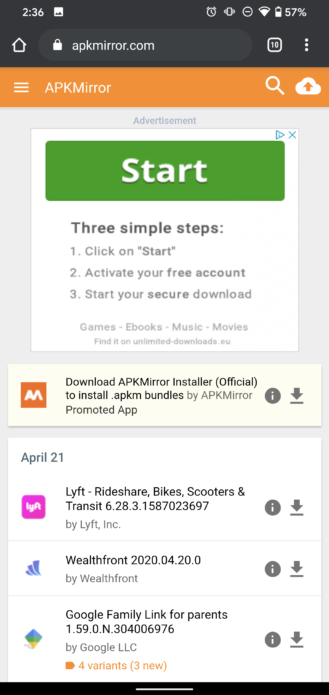
Navigate to APKMirror (apkmirror.com), and search for the app you'd like to install. Note that not all apps you can get from the Play Store may be available.
Find the app you're looking for

If necessary, you can browse apps by APK names, app names, and developer names as you hunt for whatever it is you're looking for. When you've found the app you want in the version you need, just tap the download icon on the right side of its listing.

If you end up sorting by app or developer, rather than APK, you'll then need to settle on the version of the app you want — if you don't care or don't know, the latest non-beta version is probably fine. Scroll down to "All versions" and find the one you need, then tap the download icon to the right.
Select the right version of the app

On the App listing, scroll down to the "Download" section — also easily accessed by tapping "See available APKs and Bundles." Here you may have more than one option available. If that's the case, you'll need to check the FAQ and do a bit of research to determine which version is appropriate for your phone. Tap the colorful label for the variant you'd like to download.
Although the process later should gracefully fail if you download the wrong version, you should still double-check that you have the right one. (Generally speaking, you can't mess it up too badly, though. If it installs, it was compatible, though you might run into some smaller issues with things like DPI.) In general, all modern Android phones are arm64, and a nodpi version should work most of the time.
Download the app you want to install

On the next page, scroll down to the big colorful "Download APK" or "Download APK Bundle" button — whichever it is you get, that will vary based on the app. You might be asked by your browser if you'd like to save the file, and you might get a warning that the file format/extension is potentially dangerous. If you're willing to trust APKMirror as a source, you can allow it.
Open the downloaded app in APKMirror Installer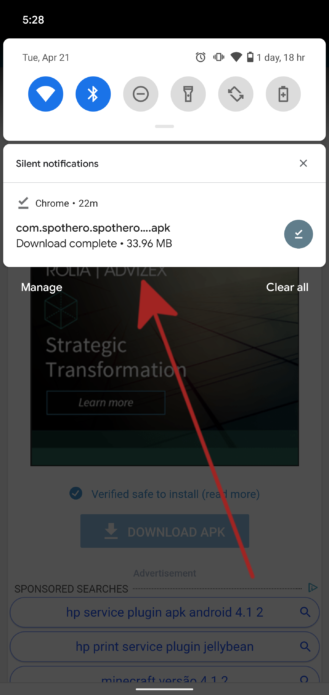

Once you've downloaded the file, you need to find a way to open it. You can tap the download notification at the bottom of the screen if you're using Chrome, for example, but you might need to tap a download notification in your status bar or navigate to where you downloaded the file with a file manager and open it manually, depending on your browser.
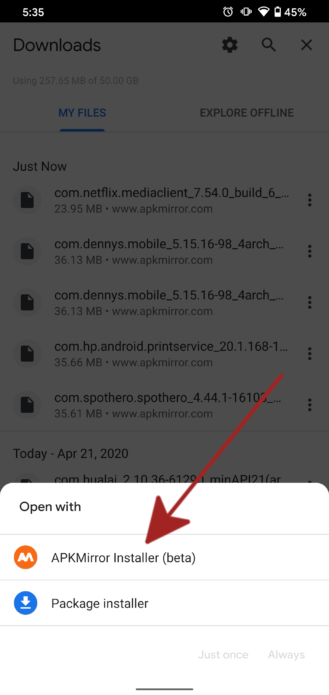

If prompted, open the file with APKMirror Installer. The APKMirror Installer app will load up the APK and get things ready.
Install the app in APKMirror Installer
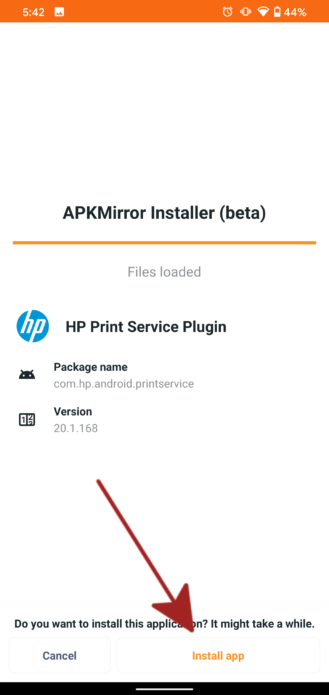
Split App Bundles (left) give you a more verbose installation screen than normal APKs (right).
APKMirror Installer will feed you a pile of details regarding the app you're installing if it's an APK Bundle — your best bet is to trust the app's judgment, though you can tweak things if you run into trouble and have to reinstall later. If you're not installing an APK Bundle, you'll get a simpler prompt. Whichever you get, tap "Install app" to continue.
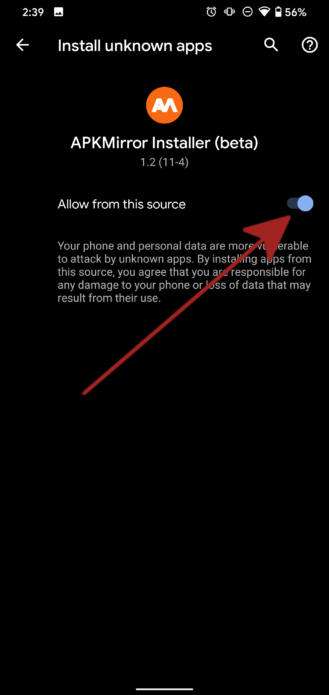
The first time you do this, you might run into trouble. On recent versions of Android, you'll be prompted to allow the APKMirror Installer app as a source for app installations as an easy toggle (visible above). While you shouldn't enable this setting for just any app, it's okay to do it for APKMirror. But it is there to protect you from apps that might install malware.
On older versions of Android (Pre-Android 8.0 Oreo — consider upgrading for your own security if your phone is this old), you'll have to manually enable a separate toggle to install apps from unknown sources. That's usually in Settings -> Security, or you can search in the Settings app for "Install apps" or "Install unknown apps."
Once the permission has been granted, you can go back until you're back in the APKMirror app, which will continue the installation process, or you can start over, attempting to run/install the app you downloaded from your browser or file manager.


APKMirror will prepare the installation, then your phone will ask (again) if you'd like to install the app, with the wording varying slightly if it's an update to an existing app or a new app for your phone entirely. Tap "Install" to continue, and you're basically done.


Once APKMirror Installer has finished installing the app, you'll be prompted to open it, but you should be running the version that you installed.
If you run into any problems during this process, APKMirror Installer will let you know, spitting a large warning if the app installation fails for any reason. So if you accidentally select an x86 APK when your phone is arm64 (like 99% of all recent phones), it probably won't work.
You can even install the Play Store if you want toUsing your new tricks, you can even finagle the Play Store itself onto your device, if you like. All you need are four apps (though you might need different versions depending on how old your phone is, or what version of Android it is running). It also may not work on all devices, and especially old or unusual devices might require tracking down specific versions of the right APKs. This guide is non-exhaustive.
Without opening any of these until you reboot at the end, install the following apps in this order:
Once all four have been installed (again, without opening them), reboot and you should have the ability to use the Play Store. If you get a notification that Play Services is out of date, don't worry. If you can sign in, everything should eventually automatically update to the latest compatible version.
If you run into trouble, most issues can either be fixed by one of the following escalating steps:
Not all devices will ultimately work with a sideloaded Play Store, and you may experience subsequent issues or odd behaviors when it comes to some apps or the device as a result, but it is an option.
Why install apps outside the Play Store?There are plenty of reasons to look for apps outside of Google's store. Odds are if you're here, you already have at least one, but there are some reasons you might not be aware of.
For one, Google sometimes removes apps from its venue based on content, functionality, or as a matter of censorship to comply with local laws. Sometimes apps are kicked to the curb for perfectly legitimate and valid reasons, like containing malware or violating user privacy, but that isn't always the case. For better or worse, Android gives you the freedom (and associated responsibility) to get your apps anywhere you like.
Another good reason to download apps from APKMirror is simply that they aren't even present on the Play Store to begin with. For example, the popular Lawnchair 2 alpha wasn't available on the Play Store before its formal release. Apps on the Play Store can also be geographically restricted/censored, and users in some countries don't have access to them. Other times, apps that are distributed on the Play Store roll out updates progressively, so when it comes to playing with the latest cutting-edge features you might read about in our coverage, you may not have access to them yet. We're all beholden to the slow Play Store roll-out.
Lastly, sometimes updates aren't always for the better, and APKMirror can provide a way to roll back to previous versions of an app in the event you run into an issue.
Whatever your motivation (and there are plenty), if you've resolved to get an app elsewhere, you can probably get it at APKMirror. And, it's also the safest choice.
You can trust APKMirrorThere are four primary reasons you can trust APKMirror as a source for Android apps:
1. We run it, and we stand by it
While Google might be responsible for the ads you see at APKMirror, we've done our best to make a good quality, easily navigated repository of Android applications. It might take you a minute to learn to navigate things like the different APK versions based on hardware platform or "DPI," but it's generally straightforward to get what you need.
2. Apps are signed by developers and safe to use
The apps that you download from APKMirror are unmolested and securely signed by their developers. We make sure that all APK cryptographic signatures are verified to match the originals (either previous updates or versions distributed on the Play Store), and we match new applications to known signatures from developers. In the event we can't verify an app's signature, APKMirror won't have it. We also block publicly disclosed test/dev/debug signing keys, since they can't always be trusted.
For the non-technically minded, that all means we're as sure as we can be that the apps we're distributing are safe.
3. No pirated or "cracked" apps
Three, there is absolutely zero pirated content on APKMirror. While you might be able to get around geographic restrictions or censorship, APKMirror doesn't provide "cracked" or pirated versions of apps (though we do host some modified apps, like Google apps tweaked to work with more devices).
Android Police and APKMirror are here to help developers, not make their lives harder or take away their ability to earn a living. Connecting with our previous point regarding safety and security, many apps modified to provide paid or premium features for free also have malware or spyware hiding inside them, which you don't want.
4. Don't just take our word for it
Lastly, even if you disagree with these arguments on the premise that we have a vested interest in promoting our own services, other impartial sources also trust APKMirror.
For more information, check out the full FAQ which can also answer other questions, like if apps downloaded from APKMirror can still be updated by the Play Store (yes), what different "arm"/DPI builds mean, or how to troubleshoot some simple errors, should you run into them.

No comments:
Post a Comment